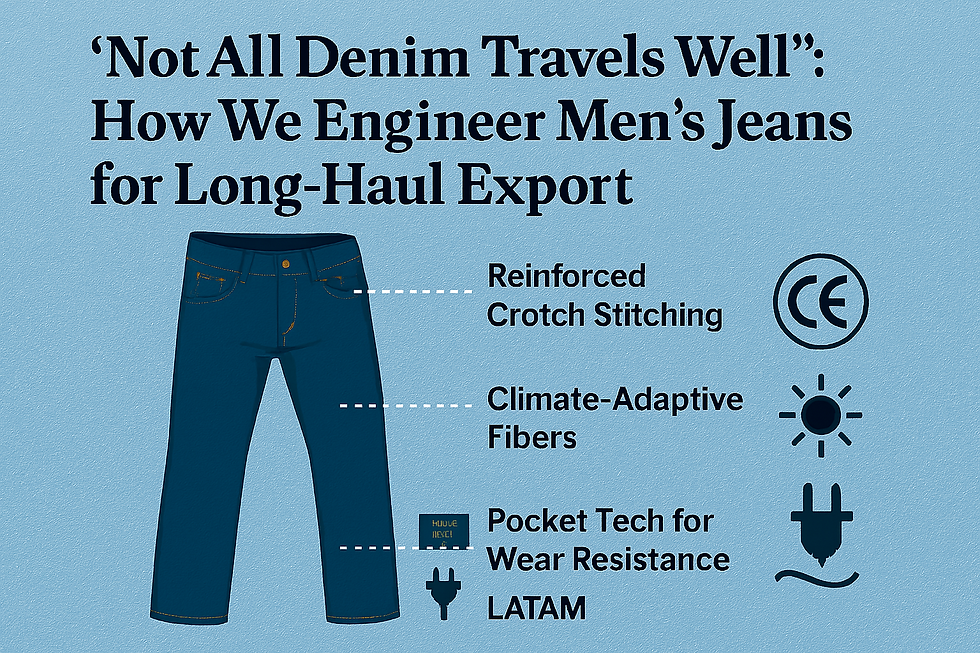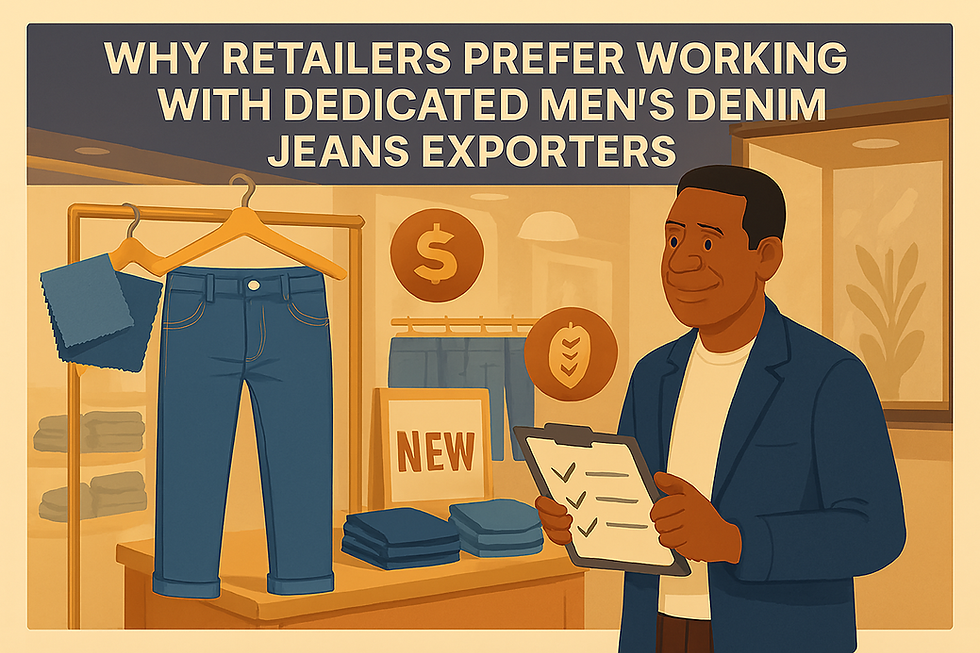Not All Denim Travels Well”: How We Engineer Men’s Jeans for Long-Haul Export
- jlintlco
- Jul 30
- 5 min read

In the global fashion industry, men’s jeans are a universal staple, transcending cultures and climates. However, exporting jeans to diverse international markets is no simple task. Not all denim travels well—variations in climate, consumer preferences, regulatory requirements, and logistics can make or break a pair of jeans’ journey from factory to wardrobe. As a leading exporter, we’ve honed the art of engineering men’s jeans to withstand the challenges of long-haul export while meeting the unique demands of global markets. In this blog, we’ll explore the complexities of exporting denim and how we tailor our jeans to ensure durability, compliance, and appeal across regions like Europe, Asia, and North America.
The Challenges of Exporting Men’s Jeans
Exporting men’s jeans involves more than packing them into shipping containers. Long-haul export exposes denim to environmental stresses, such as humidity and temperature fluctuations, while each destination market has its own standards for quality, fit, and sustainability. Additionally, consumer preferences vary widely—what’s trendy in Tokyo may not resonate in New York. To succeed, we engineer our jeans with precision, addressing these challenges through careful material selection, design adaptations, and compliance with international regulations.
Key Strategies for Engineering Export-Ready Men’s Jeans
1. Material Selection for Durability and Transport
Denim is a rugged fabric, but not all denim is suited for long-haul export. During shipping, jeans may be exposed to high humidity in cargo holds or extreme temperatures in warehouses, which can degrade fabric quality or cause issues like mold growth. To counter this, we select premium cotton blends with synthetic fibers like polyester or elastane, which enhance durability and resist moisture-related damage. For example, a 98% cotton, 2% elastane blend offers the classic denim feel with added stretch and resilience, ideal for maintaining shape during long journeys.
We also apply anti-microbial and water-repellent treatments to protect jeans during transit, particularly for markets like Southeast Asia, where humid climates are common. These treatments ensure that jeans arrive in pristine condition, free from odors or discoloration, even after weeks at sea.
2. Adapting to Regional Fit and Style Preferences
Consumer preferences for jeans vary significantly across regions, influencing our design process. In Europe, slim and skinny fits dominate, with a focus on minimalist, tailored aesthetics. We engineer jeans with precise cuts, using stretch denim to accommodate diverse body types while maintaining a sleek silhouette. Neutral washes, like dark indigo or black, are popular, so we prioritize these in our European lines.
In Asia, particularly Japan and South Korea, consumers often prefer a blend of vintage-inspired and modern styles. We craft jeans with heavier, raw denim (12-14 oz) for a structured look, incorporating details like selvedge edges and chain-stitched hems to appeal to denim purists. Meanwhile, in North America, relaxed and straight fits remain popular, especially in the U.S., where comfort is king. We use softer, pre-washed denim for these markets, ensuring a broken-in feel right out of the box.
By customizing fits, washes, and details, we ensure our jeans resonate with local tastes, increasing market acceptance and sales.
3. Compliance with International Standards
Exporting jeans requires strict adherence to international regulations, including safety, environmental, and labeling standards. For example, the European Union enforces REACH (Registration, Evaluation, Authorisation, and Restriction of Chemicals) regulations, which limit the use of harmful substances like azo dyes in textiles. We source dyes and finishes that comply with REACH, ensuring our jeans are safe for consumers and the environment.
In North America, we adhere to CPSC (Consumer Product Safety Commission) guidelines, which mandate flammability standards and clear labeling for country of origin and care instructions. For Asian markets, we comply with standards like Japan’s JIS (Japanese Industrial Standards), which emphasize fabric quality and durability. Our jeans include multilingual care labels and certifications, such as OEKO-TEX, to meet these diverse requirements and avoid customs delays.
4. Sustainable Practices for Global Appeal
Sustainability is a growing priority in global markets, particularly in Europe and North America, where consumers demand eco-friendly products. We engineer our jeans with sustainable materials, such as organic cotton or recycled polyester, to reduce environmental impact. Our dyeing processes use low-water techniques, and we partner with mills that employ energy-efficient production methods to meet certifications like GOTS (Global Organic Textile Standard).
For example, in Europe, we offer jeans made with 100% organic cotton and non-toxic indigo dyes, appealing to eco-conscious consumers. In markets like the Middle East, where sustainability is less emphasized but durability is key, we focus on long-lasting fabrics that reduce the need for frequent replacements, indirectly supporting environmental goals.
5. Packaging for Long-Haul Protection
The journey from factory to market can be punishing for denim. To ensure jeans arrive in top condition, we use specialized packaging designed to withstand long-haul transport. Each pair is individually wrapped in moisture-resistant, recyclable plastic to protect against humidity, a common issue in transoceanic shipping. We also use reinforced cardboard boxes with dividers to prevent crushing or creasing during stacking.
For markets with strict environmental regulations, like Europe, we incorporate biodegradable or reusable packaging materials to comply with waste reduction policies. This not only protects the jeans but also aligns with regional sustainability expectations, enhancing our brand’s reputation.
6. Robust Supply Chain and Logistics
A reliable supply chain is critical for successful long-haul export. We work with trusted suppliers to source high-quality denim and components, ensuring consistency across batches. Our logistics partners are selected for their expertise in international shipping, with networks that minimize delays and ensure compliance with customs regulations.
For example, when exporting to LATAM, where port delays can be common, we use expedited shipping routes and pre-clear customs documentation to streamline delivery. In contrast, for Europe, we leverage regional distribution centers to reduce transit times and costs, ensuring jeans reach retailers quickly and in perfect condition.
7. Cultural and Market-Specific Customization
Cultural nuances play a significant role in denim design. In the Middle East, where modesty is valued, we offer jeans with higher rises and longer inseams to align with cultural preferences. In Asia, where fashion-forward trends dominate, we incorporate bold details like distressed patches or embroidered designs to appeal to younger consumers. In North America, we focus on versatility, offering jeans that transition easily from casual to semi-formal settings, catering to the region’s diverse lifestyles.
We also consider sizing differences. European and Asian markets often require smaller, more tailored sizes, while North American consumers may prefer larger, relaxed fits. By customizing sizing charts and offering inclusive ranges, we ensure our jeans meet the needs of diverse populations.
How We Implement Customization
To deliver export-ready men’s jeans, we follow a structured process:
Market Research: We analyze consumer trends, regulatory requirements, and competitive landscapes in each target market to inform our designs.
Material and Design Development: We select durable, compliant, and market-appropriate materials, tailoring fits and styles to regional preferences.
Testing and Certification: Each batch undergoes rigorous testing for durability, safety, and compliance with standards like REACH, CPSC, or JIS.
Packaging and Logistics: We use protective, sustainable packaging and partner with reliable logistics providers to ensure safe delivery.
Feedback and Iteration: We collect feedback from distributors and retailers to refine our designs, ensuring continuous improvement.
Conclusion
Not all denim travels well, but with careful engineering, men’s jeans can thrive in global markets. By addressing the challenges of long-haul export—durability, compliance, cultural preferences, and logistics—we create jeans that meet the unique needs of Europe, Asia, North America, and beyond. From selecting moisture-resistant fabrics to ensuring compliance with REACH and CPSC standards, our approach combines precision, innovation, and market insight to deliver high-quality denim that resonates with consumers worldwide.
For retailers, distributors, or brands sourcing men’s jeans, partnering with an exporter who understands these complexities is essential. Our commitment to customization ensures that our jeans not only survive the journey but also exceed expectations, delivering style, comfort, and durability to customers across the globe. By engineering jeans with the end market in mind, we turn a universal staple into a tailored solution for every region.






Comments